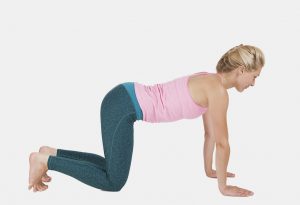Getting your body back into shape after childbirth is important as it not only improves your health but also prevents postpartum depression. Thankfully, it is not very difficult to bounce back after delivery with the help of a well-planned exercise schedule. However, depending on the kind of delivery you have had, it is best to consult with your doctor before embarking on a workout.
It is important to regain your fitness after pregnancy and a smart combination of diet and exercises can help you reach your goal in a short time. In case you experience any discomfort during exercise like bleeding or headaches, stop the routine and speak to your gynaecologist immediately.
When Can You Start Exercising After Childbirth?
Exercising is the best way to lose weight after birth and with a good control over the diet, you can bounce back into shape without much ado. It is the timing of starting an exercise schedule that is important and is a decision that should be carefully taken. Your doctor or gynaecologist will generally ask you to gradually begin exercising after the mandatory six-week post-delivery check-up is done.
If you have been conscientiously exercising during your pregnancy and had a normal delivery, then light exercises like walking and stretching are permissible. However, you should be careful not to over-exercise, especially if your body isn’t familiar with exercise routines and you have given it a miss during pregnancy. In such cases, it is best to check with the doctor and get his approval before starting any postpartum workout.
Guidelines to Follow Before Starting to Exercise
To recover from the stress of delivery and labour, it is necessary to conserve your energy before committing yourself to any exercise schedule or tummy tightening exercises. Whatever form of exercise you may choose for yourself, remember to start out slowly. Usually six weeks after delivery is safe to begin exercising (after your first post-partum check-up). This is recommended for vaginal delivery. For a Caesaream delivery, wait until eight weeks.
Beginning with a low-impact activity like walking is the perfect way to prune your body for a more strenuous regime. Walking is ideal to bring back your strength in a gradual way and you can increase the length of walks and duration progressively. Walking can help prevent blood clots and is a great way to heal your body. Attend sessions where you can learn how to exercise after pregnancy and implement them at home.
How Much Should You Exercise After Having a Baby?
New moms often wonder, “Am I doing too much exercise too soon?” Generally, it is safe to start with walking immediately after delivery (Provided you had a normal delivery). Begin slowly and gradually build up your stamina. Start with a 15 or 30-minute walk so that you can improve your blood circulation and receive some general outdoor exercise too. Continue only if you feel comfortable doing it and reduce the duration if you cannot handle the exertion. Gradually, increase your time and reach your peak at your own pace.

It is recommended to exercise three to five time a week for a duration of at least 30 minutes. After your doctor approves, you can notch your exercise level up to 60 minutes of focussed walking for 4 to 5 days a week. Increase your speed progressively to reach the optimum level, but do not stretch yourself in any way and refer to your doctor in case of any uncomfortable feeling.
How Should You Prepare for the Workouts
If you are keen on starting to exercise to reduce belly fat and regain your pre-delivery fitness, you should set a regular routine for yourself. Before starting with the workout, make sure you follow the below-mentioned steps:
- Choose loose-fitting and comfortable clothing for the workout. This will help you to remain cool.
- Feed your baby prior to getting onto the workout or express milk to avoid any discomfort.
- Select the right bra that fits perfectly and supports your breasts well during the workout.
- Keep yourself hydrated while doing these post-natal exercises by keeping a bottle of water handy.
How to Warm up Before Workout
A dedicated time has to be set aside for warm up and you should spend at least 10 minutes warming up. This is needed to get your blood flowing so that your muscles are ready for exercise. Stretch the lower back, pelvic region, and thigh muscles and hold these stretches for a few seconds before you return to the starting position. As a part of the warm-up, you can also try to walk in place.
Six Best Post- Pregnancy Exercises to Start With
1. Walking: Begin with a casual stroll around the block or in the park. Especially in the beginning, focus on the movement and you can progressively move to a power walk. Bring your baby along for the walk and put it in a front pouch to add weight, while getting some fresh air too.

Benefits: It does not need any equipment and a simple pair of running/walking shoes are enough. It is one of the simplest yet highly effective exercises for a new mother and is perfect to ease you into a more rigorous regime.
2. Deep Belly breathing with abdominal contraction: While sitting in a straight, upright position, start breathing deeply, by drawing air from the diaphragm. Hold your abs tight while contracting them and inhaling at the same time and relax them while exhaling.

Benefits: This exercise is helpful to relax muscles and is a great way to tone and strengthen your abdominal and belly area.
3. Kneeling Pelvic Tilt: Sit on all fours, with your toes and palms touching the floor. Pull your buttocks forward while inhaling, tilt your pelvis and push the pubic bone upward. Hold until three, release and repeat.

Benefits: This is one of the best exercises to strengthen your stomach and abs. It is also helpful in toning them.
4. Kegels: In the beginning, practice this routine in the bathroom while urinating. Manipulate the muscles in that area to stop the urine from flowing and then release it. Later on, contract, hold and release these muscles while you are not urinating. Do this at least 10 times, 3 sessions per day.

Benefits: It helps to tone the bladder muscles and is also helpful in reducing incontinence risks that generally follow childbirth.
5. Upper back Exercises: Cross your arms over your chest while sitting up straight. Then twist to the right and then to the left. This exercise can be repeated 10 times on each side.

Benefits: This exercise will improve your posture and relieve any pain in the upper back area. It will also give your entire back and neck area a good stretch.
6. Neck Exercises: Sit up straight and slowly move your head to the right, hold and then move to the left. Try touching your left ear to the left shoulder and the right ear to the right shoulder. Drop your chin to bend forwards and then look up to the ceiling. Do this exercise very slowly as any kind of sudden movement will result in a dizzy feeling. Stop immediately if this happens and consult with your doctor if the feeling persists for a long time.

Benefits: This will help improve your body posture which can be bent due to slumping while carrying the baby or breastfeeding it.
How Should You Relax After the Workouts?
A 5-minute cool down is necessary at the end of the workout so that your heart rate settles down to normal. You can stretch your muscles to avoid soreness and walk in place to help your body to relax. Lie down with your eyes closed for a few minutes and you are good to go.
How to Stay Motivated Once You Begin to Exercise
Stick to smaller goals and limited achievements. Setting high targets will not help as your body may not permit continuous action. Reward yourself if you manage to exercise thrice a week or if you can extend your workout every day by 10 minutes. Track your progress by using one of the many apps on your smartphone while you do these after delivery exercises to reduce stomach bulk and weight gained during pregnancy.
How to be Careful with Abdominal Muscles while Exercising
Can I exercise my lower and upper tummy? This is a common dilemma that mothers face after delivery and are keen to exercise. Many women develop a condition called diastasis recti post-delivery when a gap is created between the abdominal muscles and the same does not close after childbirth. Speak to a therapist about ab separation exercise that trainers recommend before doing it on your own.

While exercising, sit-ups and crunches are a complete no-no, as those muscles can be put under severe stress. Rectus abdominis exercises are also suggested by therapists to rectify the alignment of the abdominal muscles.
Watch out for These Warning Signs to Slow Down
- You may feel exhausted instead of feeling fresh.
- Your muscles may feel sore for a long time after the workout and sometimes feel shaky too.
- There is an increase in your morning resting heartbeat which is a clear indication that you have a vigorous physical activity going on.
- Joint, muscle pains or birth-related pains may re-emerge while exercising.
- Bleeding restarts and the vaginal discharge becomes darker in colour.
Will Postpartum Exercises Affect Breast-feeding?
No. Postpartum exercises do not affect breastfeeding in any way. In fact, these exercises contribute towards overall wellness and health and is good to bounce back after the stresses of pregnancy and delivery. Muscles post pregnancy need to be loosened and exercised to help you to manage the baby and the additional responsibility and exercises do not affect breastfeeding or any other function of a mother.
FAQ’s
1. Which post pregnancy exercises you should not be doing?
Swimming should be completely avoided until you have stopped having vaginal bleeding or discharge for six days. Exercises involving a hands and knee position should be avoided during the first six months since a clot can be formed in the place where the placenta was located.
2. How should I strengthen my pelvis and back?
Pelvic floor exercises are recommended to strengthen the pelvis and back. Remember these exercises will take at least 8 to 12 weeks to gain strength so keep going and do not give up in between.
3. I had a caesarean. Can I exercise in the first few weeks?
Yes, you can. In fact, you will find it easier than someone who has had a vaginal delivery, since your muscles will be stronger. Of course, avoid picking up heavy weights and resort to simple exercises like walking before moving on to a rigorous schedule.
Exercising is a vital part of the post-delivery period. It is necessary to follow the instructions provided by the doctor to ensure there are no side effects of the workouts. It helps the mother in gaining confidence about her body shape, weight, and plays a major role in reducing postpartum depression.
